Atlas
Production and Launch Operations
Production
Atlas V production occurs in Decatur, Alabama, in ULA’s state-of-the-art manufacturing facility. The Decatur facility has a diverse array of technical expertise and equipment that permits in-house fabrication and final assembly of the Atlas booster and the Centaur upper stage.
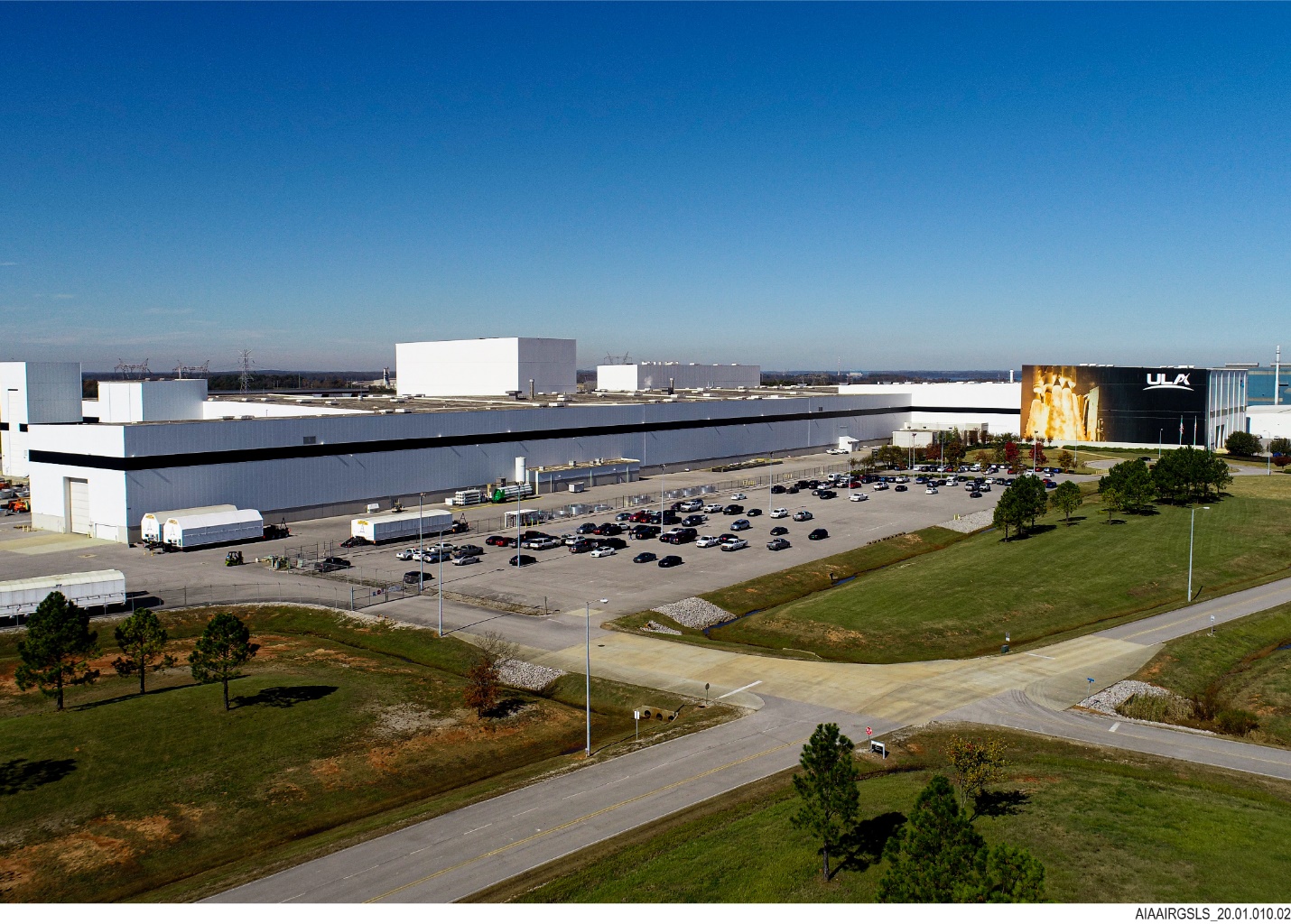
Launch Operations
LC-41
East Coast Atlas V launches are conducted from Launch Complex-41 (LC-41) at Cape Canaveral Air Force Station (CCAFS) adjacent to the launch complex. The VIF has a 54,000-kg (60-ton) crane for stacking vehicle elements. The spacecraft is hoisted into position three days before launch. The day before launch the launch vehicle is rolled out to the launch pad on the 700-ton (1.5-million-lb) Mobile Launch Platform (MLP). The MLP includes an umbilical mast that provides all fluid, electric, and conditioned air connections to the launch vehicle. The pad itself is a simplified facility, and includes a flame trench, equipment vaults, four lightning protection towers and tank farms for propellants and gases. There is no launch pad umbilical tower or mobile service tower as is typically used for launch vehicles of this size.
Launches are controlled from the new Atlas V Spaceflight Operations Center (ASOC), 6.6 km (4.1 mi) from the launch pad. The ASOC combines a high bay, where Atlas V elements are received for testing before delivery to the VIF, a Launch Operations Center, a customer viewing area overlooking the Launch Operations Center, secure customer work areas and hospitality areas for viewing the launch.
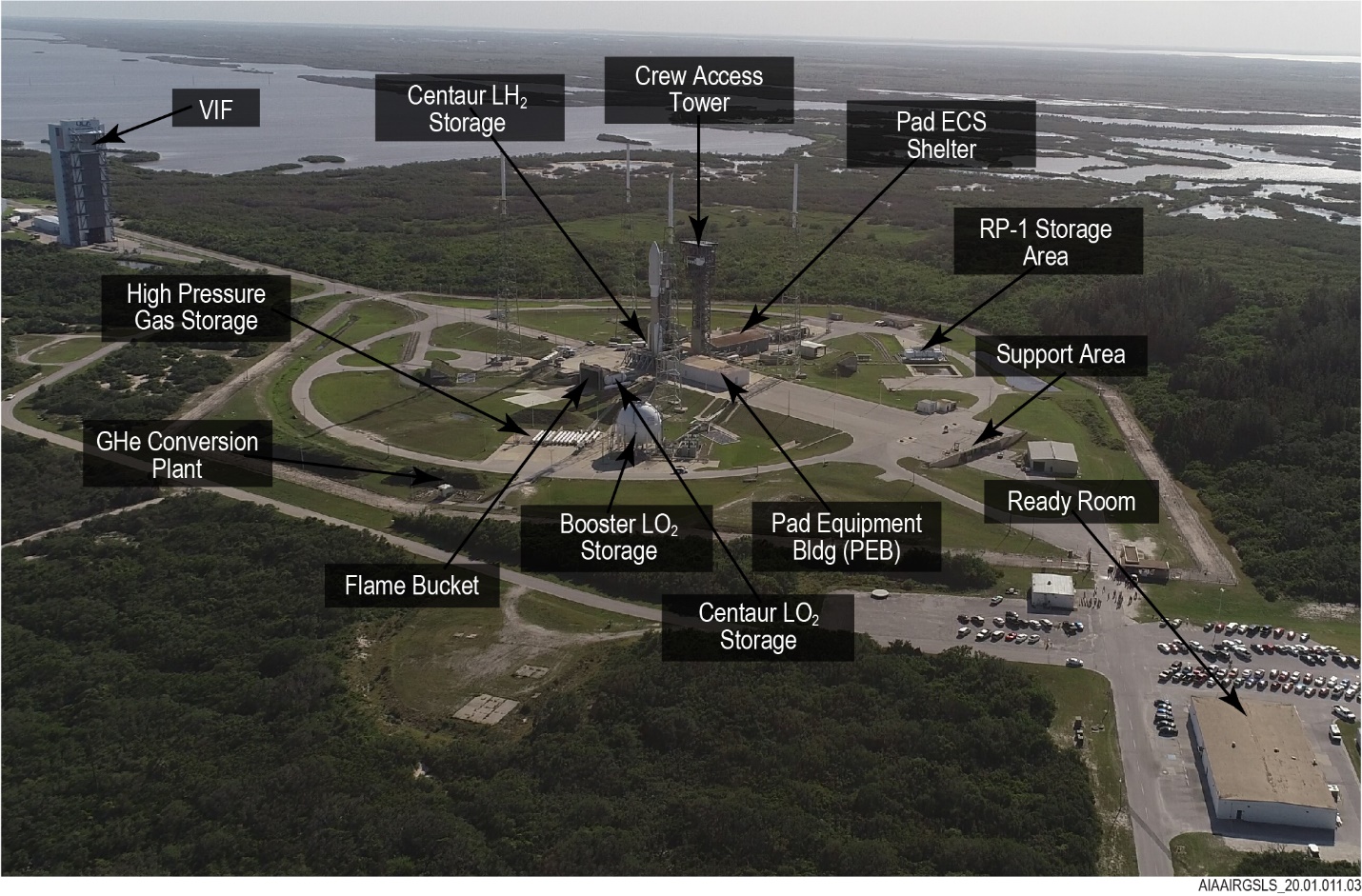
Atlas V launch facilities at CCAFS LC-41. The Vertical Integration Facility (VIF) is on the left. The Mobile Launch Platform is shown in the launch position in the center, surrounded by four lightning towers.
SLC-3
West Coast Atlas V launches are conducted from Space Launch Complex-3 (pad SLC-3E). SLC-3 at Vandenberg Air Force Base (VAFB) in California has supported the launch of Atlas vehicles since the 1970s. In 1992, the USAF contracted with ULA to convert the inactive SLC-3E site to support the launch of Atlas/Centaur to orbits not attainable from the East Coast CCAFS launch site. The initial operational capability of SLC-3 for Atlas IIAS was late 1997. The launch complex was modified to accommodate Atlas V launch vehicles.
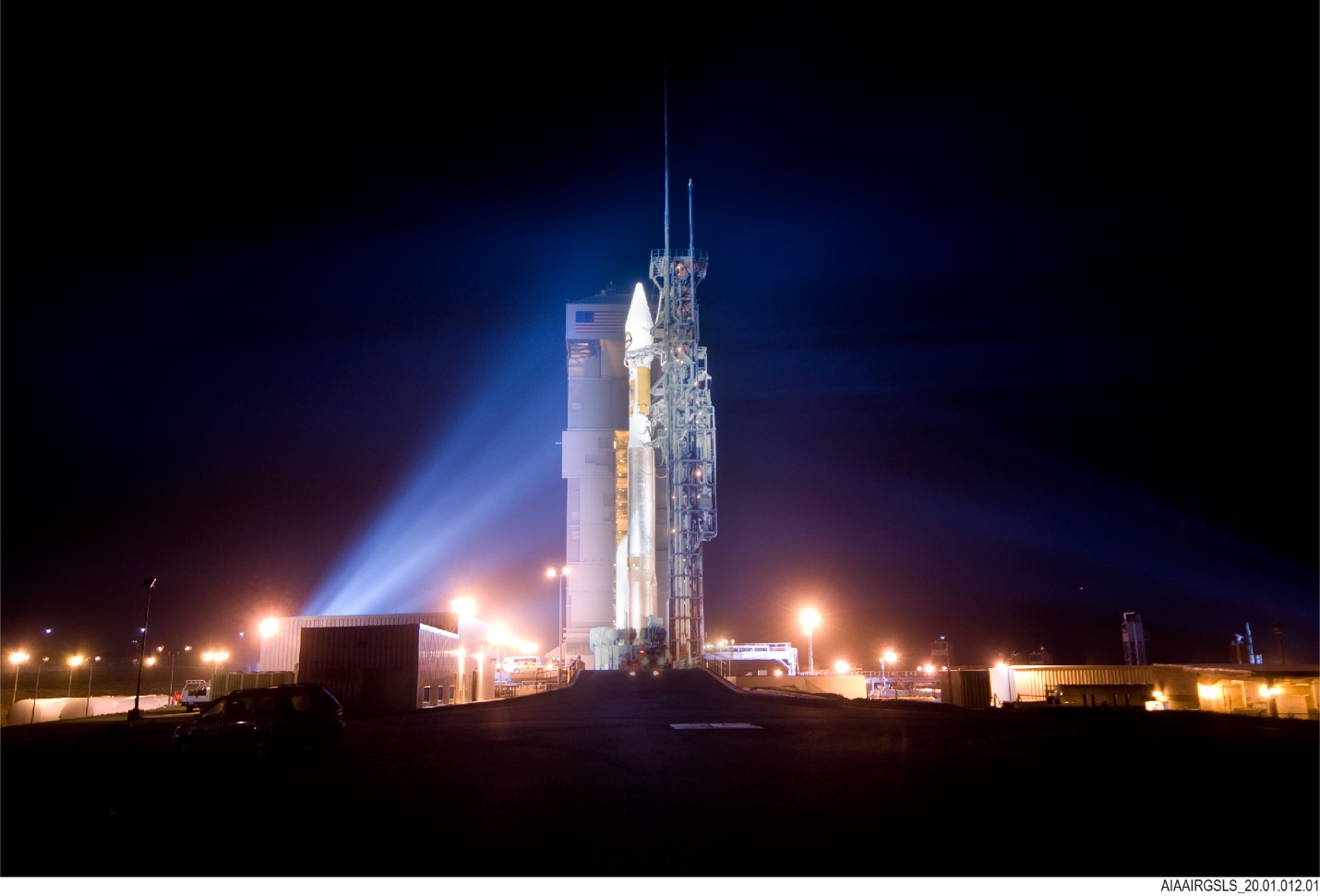
Mission Profiles
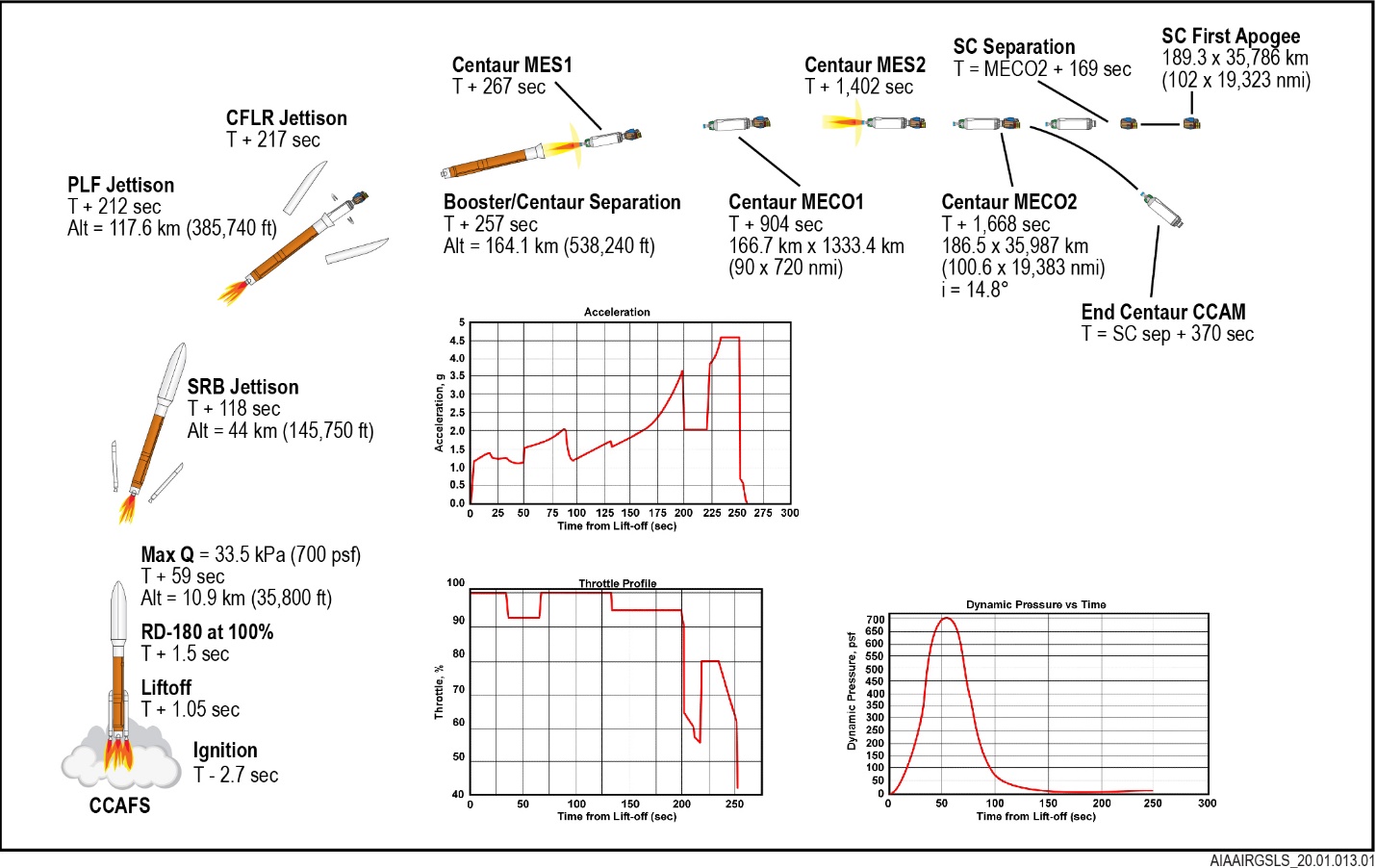
Typical Atlas 521 Short Coast GTO Ascent Profile. (MES = Main Engine Start, MECO = Main Engine Cut Off, CCAM = Collision and Contamination Avoidance Maneuver)
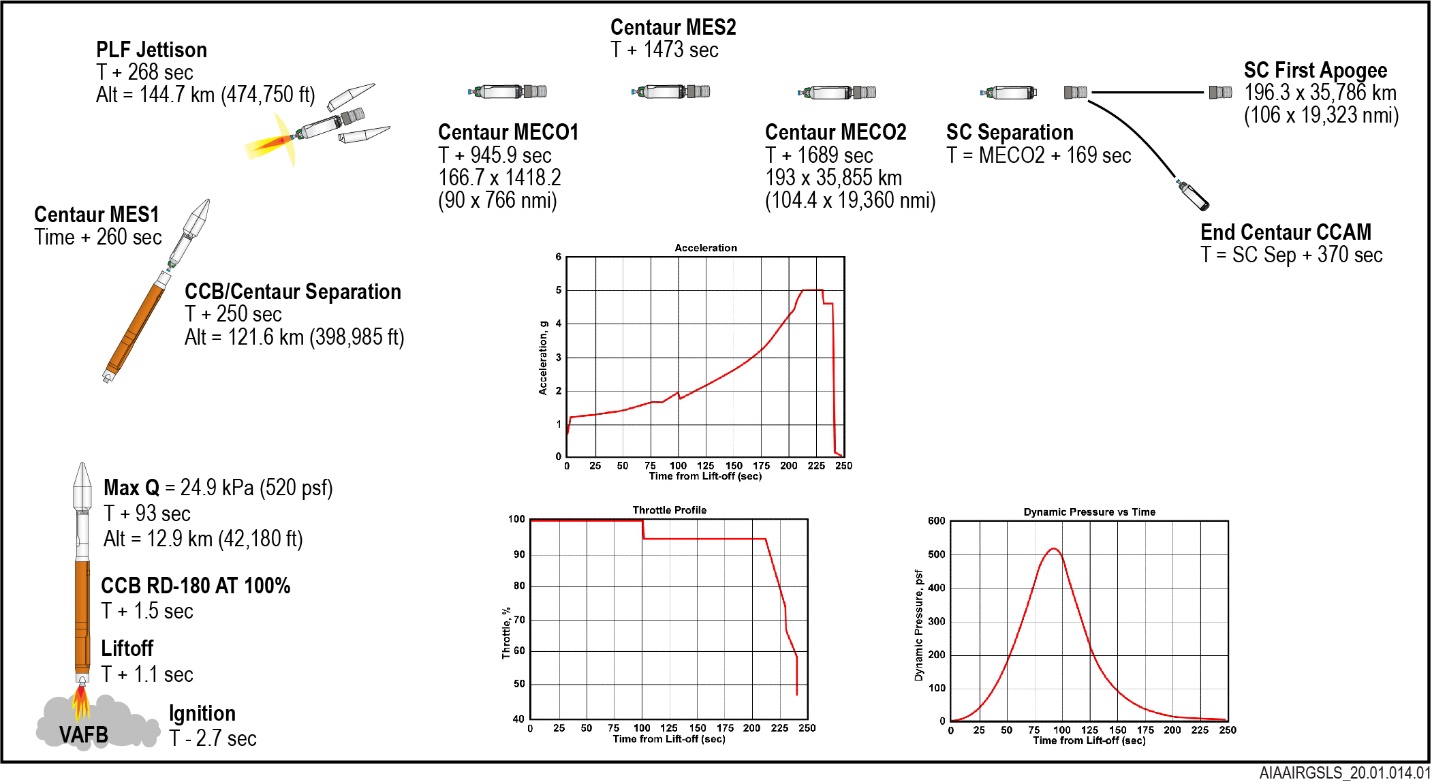
Typical Atlas 401 Short Coast GTO Ascent Profile.
Vehicle History
Vehicle Evolution

Vehicle Description
• | A | ICBM single-stage test vehicle |
• | B and C | ICBM 1-1/2 stage test vehicles |
• | D | Operational ICBM and later space launch vehicle |
• | E and F | First ICBM (1960), then reentry test vehicles (1964), then space launch vehicles (1968) |
• | LV-3A | Same as D with added Agena upper stage |
• | LV-3B | Same as D except human-rated for project Mercury |
• | SLV-3 | Same as LV-3A except reliability improvements |
• | SLV-3A | Same as SLV-3 except stretched 2.97 m (117 in) |
• | LV-3C | Launched with Centaur D upper stage |
• | SLV-3C | Same as LV-3C except stretched 1.3 m (51 in) |
• | SLV-3D | Same as SLV-3C except Centaur uprated to D-1A and Atlas electronics integrated with Centaur |
• | G | Same as SLV-3D but Atlas longer 2.06 m (81 in) |
• | H | Same as SLV-3D except with E / F avionics and no Centaur upper stage. |
• | I | Same as G except strengthened for 4.27-m (14-ft) payload fairing and ring laser gyro added |
• | II | Same as I except Atlas lengthened 2.74 m (108 in), engines uprated, added hydrazine roll control, fixed foam insulation, deleted verniers, and Centaur stretched 0.9 m (36 in.) |
• | IIA | Same as II except Centaur RL10 engines uprated to 88 kN (20 klbf) of thrust and 6.5 s Isp increase from extendible RL10 nozzles |
• | IIAS | Same as IIA except 4 Castor IVA strap-on boosters added |
• | IIIA | Similar to IIA, with new RD-180 first-stage engine, first-stage booster-sustainer separation eliminated, first stage stretched 4.4-m (14.5-ft), single-engine Centaur. |
• | IIIB | Same as IIIA, except single- or dual-engine Centaur, and Centaur extended 1.7 m (5.5 ft) |
• | V 400 | Similar to IIIA with new common core booster first-stage structure |
• | V 500 | Similar to V 400 with optional solid strap-on boosters, Centaur encapsulated inside 5.4-m (17.7-ft) payload fairing |
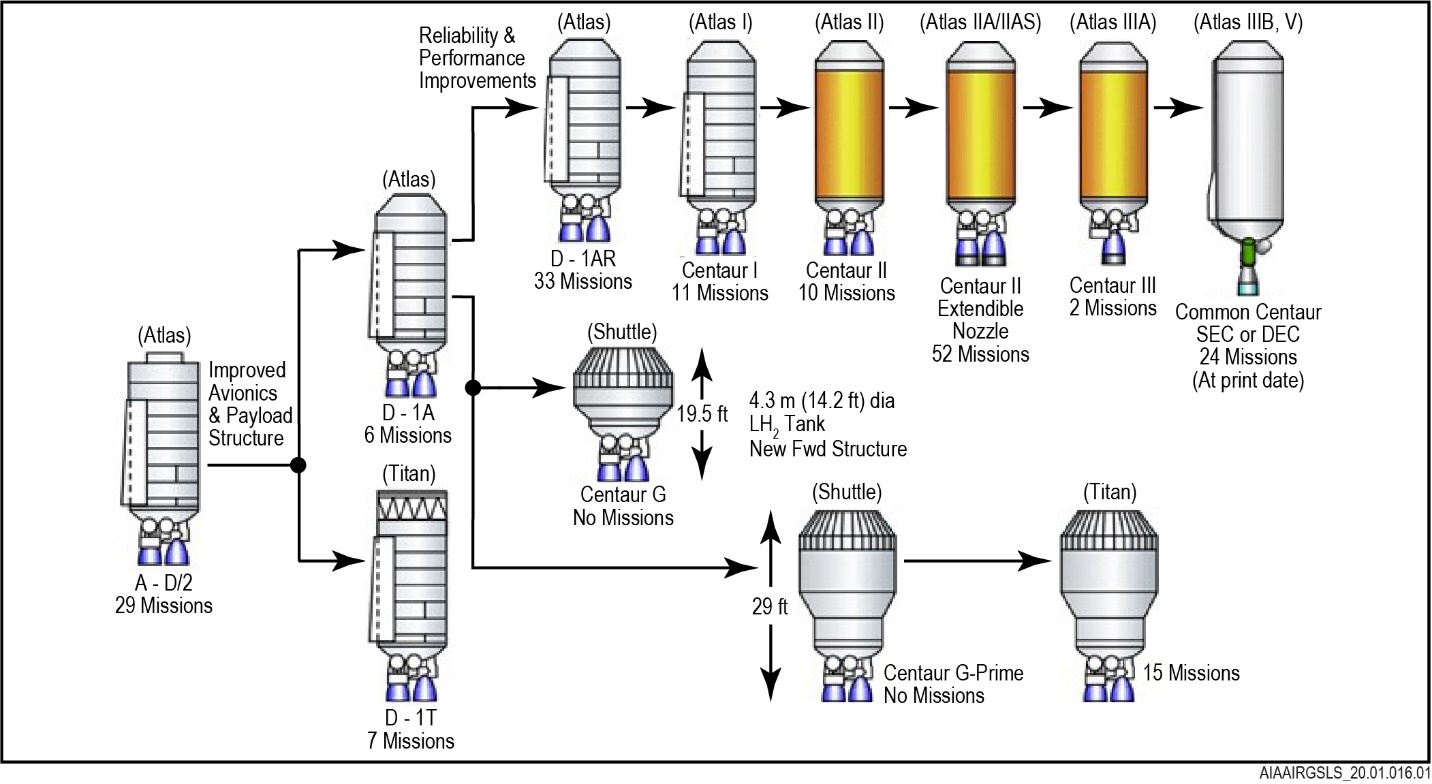
Centaur Evolution through the vehicle configurations.
Centaur Genealogy
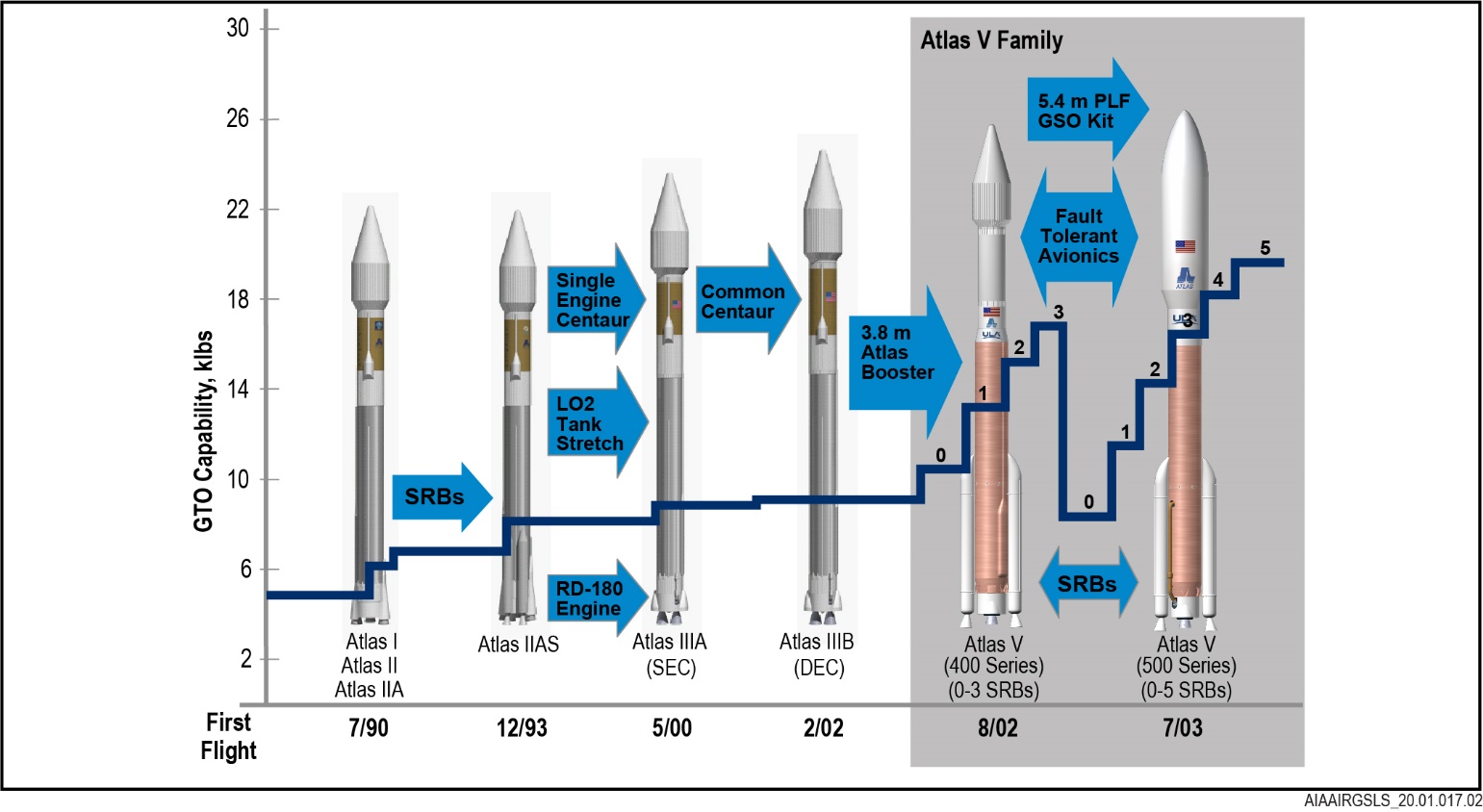
Atlas family GTO Performance evolution.
Historical Summary
The Atlas space launch vehicles evolved from the successful Atlas ICBM. While the Atlas has grown dramatically and evolved over the years, many of its features can be traced back to its early missile heritage.
The Atlas ICBM project was initiated by General Dynamics as project MX-774 for the U.S. Air Force in 1945. After being canceled in 1947 for lack of funds, it was reinstated four years later. The ICBM underwent a major scaling down in 1955 as a result of breakthroughs in thermonuclear weapons and made its first test flight two years later. From 1957 to 1959, research and development on Atlas produced the A, B, and C versions. A modified Atlas B was used for Project SCORE on one of its 10 successful tests during 1958 and 1959. Project SCORE, the first of many notable space launch missions performed by an Atlas vehicle, was the world’s first communications satellite. Launched in 1958, this satellite transmitted President Eisenhower’s Christmas message. Atlas development continued with an improved guidance system on the Atlas C. The Atlas A, B, and C versions had a total of 23 research and development flights and led to the first operational Atlas flight using the Atlas D in 1959.
The Atlas D could be called the “granddaddy” of the Atlas II/III vehicles. It was launched more times (123) than any other version of Atlas and was human-rated for use on the historic Mercury program. The Atlas D used a cluster of three engines (two boosters, one sustainer) to comprise its one and one-half stages. Igniting the sustainer engine on the ground before liftoff reduced concern over the reliability of lighting upper-stage engines in flight. This staging scheme, which was first tested on the Atlas B, was to be used on all of the following Atlas vehicles until the development of the Atlas III series vehicles at the end of the century.
The Atlas D was the basis for two distinct branches of Atlas vehicles. One branch contained the Atlas E and F ICBMs, which were used with the Atlas D in the U.S. missile silos. The other branch grew from the use of the Atlas D as a space launch vehicle. The Atlas D was modified, human-rated and called the LV-3B for the Mercury missions. The 28.8-m (94.5-ft) tall Atlas used the same basic Atlas D system with the addition of a 1,400 kg (3,000 lbm) crewed Mercury capsule on top. Unlike Project SCORE, in which the payload and Atlas sustainer remained attached, the Mercury payloads were separated to fly independently after orbit was achieved. The Mercury capsule had been tested on suborbital flights launched on Redstone rockets, but the larger Atlas booster was needed to put Mercury in orbit. On Feb. 20, 1962, after a successful launch on the human-rated Atlas D, John Glenn became the first U.S. astronaut to orbit Earth. Seven of the ten Mercury flights were successful, including all four crewed missions.
The Atlas space launch vehicle also was used in all of the early uncrewed lunar exploration missions: Ranger, Lunar Orbiter and Surveyor. Finally, Atlas Centaur vehicles launched Mariner probes to Mars, Venus and Mercury and the Pioneer probes to Jupiter, Saturn, and Venus.
As needed, additional Atlas D vehicles were converted to Atlas LV-3A or LV-3C configurations by modifying vehicle structure and subsystems for each mission to be flown. This led to a successful set of launch vehicles and upper stages. LV-3A used the Agena upper stage, and LV-3C used the Centaur upper stage. Centaur was a new upper stage that used cryogenic hydrogen and oxygen for the first time in a launch vehicle. The high-performance Centaur was especially useful for high-energy missions and would eventually become the standard Atlas upper stage. In 1962, management for both the Atlas Agena and Atlas Centaur programs was transferred to the NASA Lewis Research Center. The LV-3A was involved heavily in the Ranger and Mariner programs; it made a total of 43 successful launches in 53 attempts. The LV-3C’s 11 successes in 12 attempts consisted of research and development flights for the Centaur and Surveyor lunar landers.
Unfortunately, the mission tailoring that was required to convert Atlas missiles to space launch vehicles caused long lead times that detracted from their low cost. As a result, a contract was awarded to General Dynamics in 1962 to develop a standardized launch vehicle (SLV). The SLV line began with the SLV-3. This vehicle, like its predecessor the LV-3A, used primarily Agena upper stages. From its first launch in August 1964 to its final launch in August 1968, the SLV-3 was successful on 49 of 51 orbital launch attempts, including all five Lunar Orbiter flights.
In 1965, the Convair Division of General Dynamics won a contract to improve the performance of its vehicles and introduced the SLV-3A and -3C. Both vehicles had been lengthened to add propellant and had increased engine thrust and reduced vehicle weight. They used the Rocketdyne MA-5 engine system with a total thrust of 1.92 MN (431,300 lbf). The radio-guided SLV-3A stood 24.0 m (78.7 ft) tall by itself—3.0 m (9.75 ft) taller than the SLV-3—and 36.0 m (118 ft) tall with an Agena upper stage and payload fairing; it could deliver 3,900 kg (8,500 lbm) of payload into a 185 km (100 nmi) circular orbit with the Agena. The SLV-3A was used primarily for classified missions and was successful on 11 of 12 flights. The SLV-3C was similar to the SLV-3A, but was designed for use with the Centaur D upper stage. It successfully completed all of its 17 missions.
Because the Centaur was emerging as an exceptional upper stage, the SLV-3C evolved into the SLV-3D. Unlike its predecessor, the SLV-3D was integrated electronically with the new Centaur D-1A upper stage. Thus, the Centaur's autopilot and guidance systems were used to control the launch vehicle, as opposed to earlier vehicles that were guided by an independent Atlas autopilot. Most other systems remained the same as those in preceding SLVs, including the same engine thrust as the SLV-3C. The SLV-3D stood 21.2 m (69.5 ft) by itself and 59.5 m (131 ft) with the Centaur and payload fairing added. All 32 SLV-3D launches used Centaur D-1As; its 30th success took place on the last launch in May 1983.
As the Atlas was progressing as a space launch vehicle, it also was developing as an intercontinental ballistic missile (ICBM). Atlas Es and Fs were being developed along with Atlas Ds as U.S. ICBMs in the late 1950s. The Atlas E and F were virtually identical one and one-half stage vehicles that used inertial guidance. A major dif- ference between the E/F vehicle and the SLVs was that the E/F used a Rocketdyne MA-3 engine system instead of the MA-5. The Atlas E and F were deployed in U.S. missile silos for much of the 1960s until they were replaced by the Minuteman in 1965. The Atlas F then was used primarily for the advanced ballistic re-entry system (ABRES) program from 1965 to 1974. By the late 1970s, the remaining Atlas Es and Fs were converted for space launch. The Atlas E or F could place 795 kg (1750 lbm) into polar LEO with no upper stage. The last Atlas E launch took place in 1995.
Two vehicles emerged from the SLV-3D: the Atlas H and the Atlas G. The Atlas H used most of the basic SLV systems but employed the radio guidance and avionics of the Atlas E. The MA-5 engines used LOX/RP-1 propellants and provided over 1954 kN (43.3 klbf) of thrust; 1679 kN (377.5 klbf) from two booster engines, 269 kN (60.5 klbf) from a sustainer and 5950 N (1338 lbf) from two verniers. In place of the Centaur, the Atlas H used a solid propellant kick motor as a second stage to propel up to 2,000 kg (4,400 lbm) into polar LEO. The Atlas H was successful on all five of its launches; the last launch occurred in 1987.
The Atlas G was a stretched version (22.2 m [72.7 ft] tall) of its predecessor, the SLV-3D. Its MA-5 engine provided 33.3 kN (7500 lbf) more thrust than the SLV-3D’s MA-5. The Atlas G was designed for use with the Centaur D-1A upper stage, including use of the Centaur guidance system. The Atlas G/Centaur combination stood 41.8 m (137 ft) tall and was capable of delivering 2,400 kg (5,200 lbm) to GTO.
As a result of an unprecedented string of launch vehicle failures and a related decision to remove commercial payloads from the Space Shuttle manifest, General Dynamics decided in 1987 to develop and build 18 Atlas/Centaurs (designated Atlas I) for commercial sale without having firm contracts for their purchase. Two new metal payload fairings were introduced with 3.3-m (11-ft) and 4.2-m (14-ft) diameters. The Atlas I began launching in 1990, but suffered 3 failures in 11 launches before it was phased out in 1997.
In May 1988, the U.S. Air Force chose General Dynamics to develop the Atlas II vehicle, primarily to launch Defense Satellite Communications System (DSCS) payloads. Subsequently, General Dynamics decided to scale back the Atlas I program to 11 vehicles and use the excess assets for the Atlas II series vehicles. The basic Atlas II configuration was developed in response to a Department of Defense requirement for a medium-lift launch vehicle (MLV-2) to boost 10 DSCS satellites into orbit. The Atlas booster was stretched 2.7 m (9 ft) and employed an improved Rocketdyne engine set, the MA-5A. The booster engines had an increased thrust level of 1,842 kN (414 klbf), but the sustainer engine was not modified and provided the nominal 269 kN (60,500 lbf) of thrust. The vernier engines were replaced by a hydrazine-fueled ARCM mounted on the interstage adapter. In addition, the Centaur upper stage was stretched by 0.9 m (3 ft), and its old fiberglass honeycomb insulation panels were replaced with fixed polyvinyl chloride foam panels. With the 3.3-m (11-ft) payload fairing, this configuration was capable of placing 2,770 kg (6,100 lbm) into GTO. All 10 Atlas II launches were successful, with the last flight occurring in 1998.
In addition to the basic Atlas II, two advanced versions were developed, primarily for the commercial market. The Atlas IIA and IIAS include an upgraded RL10 engine, providing 90 kN (20,250 lbf) of thrust, and extendible nozzles to add 6.5 s of specific impulse. In addition, the Atlas IIAS adds four Thiokol Castor IVA solid rocket motors (SRMs) to the booster stage. Each SRM provides an average thrust of approximately 434 kN (97,500 lbf). The Atlas II, IIA, and IIAS were very successful in the commercial space launch industry, in part because of their 100% reliability.
The Atlas program went through several dramatic changes during the mid 1990s. After decades at General Dynamics, the Atlas and Centaur programs were sold to Martin Marietta in 1994. Most production moved from San Diego to the Martin Marietta facilities in Denver during 1995, just as the company was merging with Lockheed to become Lockheed Martin. In late 1995, the new company announced that it would fund significant upgrades to the Atlas vehicle. The new Atlas, initially designated IIAR, would have new engines, a single-stage booster (thus eliminating the characteristic stage-and-a-half design) and a single-engine Centaur stage. Reductions in parts count, number of engines and staging events were expected to increase reliability and reduce cost. The new RD-180 engine, the product of a joint venture between Pratt & Whitney and the Russian engine manufacturer NPO Energomash, was selected over the Rocketdyne MA-5D and the Russian NK-33 for the first stage. The new engine offers significantly higher thrust and specific impulse than its predecessors, and also incorporates throttling capability for the first time, thus reducing launch loads on the payload. In 1998, Lockheed Martin announced that the Atlas IIAR would instead be designated the Atlas IIIA, and that it would also develop the Atlas IIIB, with a longer dual engine Centaur stage for further performance increases. The Atlas IIIA was first launched in 2000, and the IIIB in 2002. However, attention was already shifting to the next step, the Atlas V.
The Atlas V was designed as part of the USAF Evolved Expendable Launch Vehicle (EELV) program, which began in 1995. The Lockheed Martin approach was based on an evolution of their existing Atlas II/III product line. The Atlas V has a structurally stable first stage powered by the NPO Energomash RD-180 engine. The second stage is an evolution of the Atlas III stainless steel Centaur hydrogen/oxygen vehicle continuing to be powered with engines from the RL10 family. The first Atlas V flew in August, 2002. Since then, every configuration of the vehicle has flown except the 511, which will fly in 2020. In 2006 Lockheed Martin and The Boeing Company formed a joint venture, bringing the Atlas V, Delta II and Delta IV vehicles together under the United Launch Alliance.